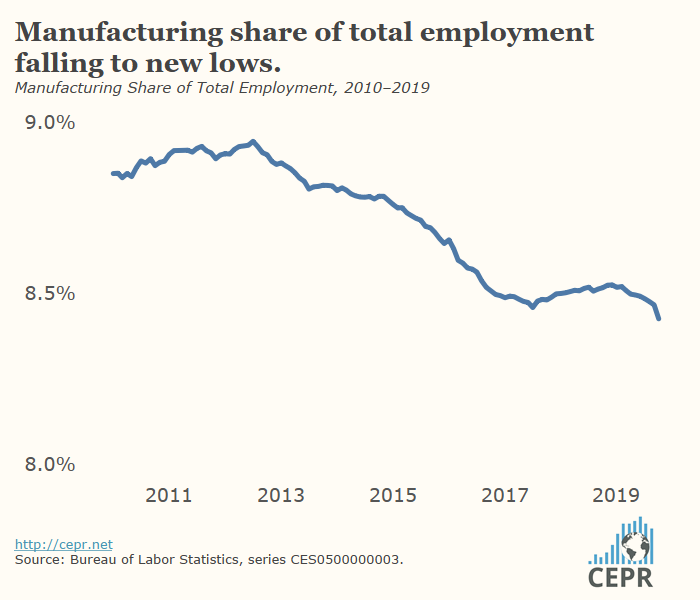US Economy Creates 128,000 Jobs In October; Unemployment Edges Up To 3.6 Percent – Analysis
By Dean Baker
The Bureau of Labor Statistics reported that the economy added 128,000 jobs in October, while the unemployment rate edged up to 3.6 percent. The unemployment rate for blacks fell to 5.4 percent, another record low.
The job growth for October was depressed by the United Auto Workers strike at General Motors. This reduced manufacturing employment by more than 40,000. This drop will be reversed in November, but it pushed manufacturing employment’s share of total employment down to 8.4 percent, the lowest on record. In looking at the October job growth data, it is also important to note sharp upward revisions to the prior two months’ data, bringing the three-month average to 176,000.

There was an extraordinary jump of 47,500 jobs in restaurants in October, which accounted for 37.1 percent of job growth for the month. With upward revisions to job growth in this sector for the prior two months, the three-month average has been 38,000. This is surprising given the low overall unemployment rate. Restaurants jobs tend to be low-paying, with few benefits, and for this reason, they often go unfilled in a tight labor market.
Construction added 10,000 jobs in October. Average job growth in the sector has been just 6,300 a month since June, down from an average of 18,100 in the 12 months prior to June. Health care added just 14,600 jobs in October, down from an average of 33,500 over the last year.
There was also some slowing in the high-paying professional and technical services sector. It added 16,500 jobs in October, compared to an average of 22,600 over the last year. Trucking added 1,300 jobs last month, but it is still down 7,300 jobs from its June peak. The retail sector added 6,100 jobs, its second consecutive month of growth, but employment is still down by 22,100 (0.1 percent) from its year-ago level.
Wage growth remains stable with the average hourly wage 3.0 percent above its year-ago level. With a modest decline in the length of the average workweek, the average weekly wage is just 2.7 percent above its year-ago level. This is consistent with the data in the Employment Cost Index for the third quarter, which showed compensation growth of 2.8 percent over the last year, unchanged from the year-ago pace.
Most of the data in the household survey were positive. While the overall employment-to-population ratio (EPOP) was unchanged at a recovery high of 61.0 percent, the EPOP for prime-age workers (ages 25 to 54) rose 0.2 percentage points to 80.3 percent, a new high for the recovery. The EPOP rose for both men and women. The EPOP for women was 74.2 percent, a new high for the recovery, 0.8 percentage points above its year-ago level. The EPOP for men was 86.5 percent, 0.3 percentage points above its year-ago level.
The percentage of unemployment due to voluntary quits edged down to 14.5 percent but is still near the high for the recovery. There was little change in the duration measures of unemployment.
The number of people working part-time for economic reasons rose by 88,000 but is still almost 200,000 below its year-ago level. The number of people voluntarily working part-time edged down by 24,000. This figure has lagged in the last year, with the average for 2019 just 0.4 percent higher than for 2018, meaning that it is dropping as a share of total employment. This is consistent with a situation where it is more difficult to get health care insurance outside of employment.
Looking at unemployment rates by education level, college grads continue to be relative losers. Their 2.1 percent unemployment rate is actually up 0.1 percent from the year-ago level and still 0.3 percentage points above prerecession lows. By contrast, for workers with just a high school degree, their 3.7 percent unemployment rate is down 0.3 percentage points from year-ago levels and is 0.3 percentage points below its prerecession low.
On the whole, this is clearly a positive report. The economy is adding jobs at a healthy pace. There are signs of weakness in key sectors such as construction and manufacturing (even when pulling out the effect of the GM strike). Also, wage growth is surprisingly weak given the low unemployment rate, but there is no sign of a recession anywhere in sight.

